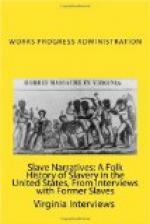The births recorded in the Bible are as follows and in the exact order given below:
Mary Patterson 10-11-1866 Harris Donesson 3-13- 72 Lilley Donesson 7-21- 85 Pearly Donesson 3-29- 92 Silvay Williams 8-29- 84 Beney Williams 11-24- 85 Millia A. Williams 12-30- 88 Joe Patterson 10- 3- 77 H. Patterson 7-29- 79 Maria E. Patterson 11-19- 81 Jennie Patterson 12-24- 84 Alex Patterson 7- 5- 86 James Patterson 6-20- 90 Janie Patterson 1-27- 60 Amanda Patterson 1-28- 63 James Rafield Walker 8-11- 99 Cornelius Walker 7-21-1902 Willie Walker 11-20- 03 Elias Walker 7-21- 11 Emmet Brown 1-23- 22 Leon Harris 12-13- 21
The following marriages were given:
May Lee Brown 2-26-1926 James Walker Brown 2-21- 35 Jennie Walker 6-20- 15 Lillie Jean Walker 12-6- 36
The name of Sarah Jane Patterson is not in the list. The list itself is not chronological. It is written in ink but in the stiff cramped hand to be expected of a school child not yet thoroughly familiar with the pen. The eye fixes on the name of Janie Patterson, 1-27-1860. It does not seem probable that this is correct if it is meant to be Sarah Jane. Sarah Jane could give no help except to answer questions about the manner in which the record was made.
These considerations led me to set the record aside in my own mind so far as Sarah Jane Patterson’s age is concerned and to take her word. She has a very clear conception of the change from slavery to freedom. Her memories are blurred and indistinct, but she recollects that this matter was during slavery times and that during freedom. It seems that she had the care of the smaller children during slavery time—at the time she saw the soldiers marching through. This was not during the time of freedom, because she distinguished clearly the Ku Klux time. She would have to be at least eighty to have cared for children. Her tenacious memory of ninety may have some foundation, therefore.
Moreover where writing is done in lead pencil and hurriedly, six is often made to look like four and a part of eight may become blurred till it looks like a zero. That would account for 1848 being transcribed as 1860. There would be nothing unusual, however, in a Sarah Jane and a Jane. I neglected to cover that point in a question.
Interviewer: Samuel S. Taylor
Person interviewed: Solomon P. Pattillo
1502
Martin Street, Little Rock, Arkansas
Age: 76
Occupation: Formerly farmer, teacher, and small
dealer—now blind
“I was born November 1862. I was three years old at the time of the surrender. I was born right here in Arkansas—right down here in Tulip, Dallas County, Arkansas. I have never been out of the state but twice.




